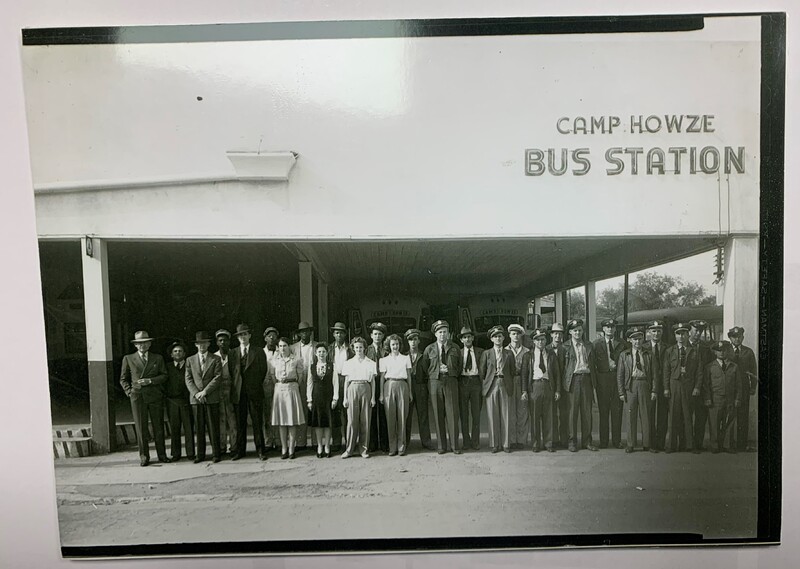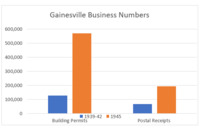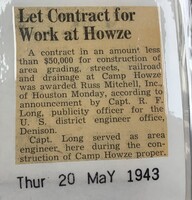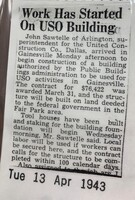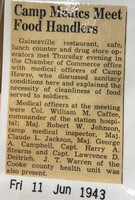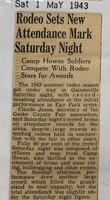Local Businesses
Camp Howze brought a much-needed boost to Gainesville’s economy due to increased demands from the soldiers, and many new jobs being created for the operation of the camp. Civilians were employed for the construction, operation, and deconstruction of the camp, providing income for many families and local businesses. The influx of people created a greater need for transportation, which caused the local train lines to increase the number of train cars and hours of operation. Local merchants had to hire more help due to more demand, and retail sales rose from four million in 1939 to nearly eight million in 1944. The Cooke County fairgrounds were built as a direct result of the camp's proximity, and several local establishments were able to make additions to existing buildings, such as the First Baptist Church of Gainesville. Camp Howze created many new job opportunities that were previously closed to women, as well as supplied Soldiers and POW labor for struggling farms in the area. The camp had a major economic impact on the city of Gainesville and its inhabitants that can still be seen to this day, and the following are just a few examples of these impacts.
Camp Howze caused significant impacts on Gainesville's economy, in turn allowing citizens to build more homes and businesses. Building permits increased from $127,853 in 1942, to &570,000 in 1946. The post office in Gainesville also hit higher numbers due to the soldiers from Camp Howze, as postal receipts went from $66,612 in 1942 to an all-time high of $193,000 in 1944.
This Chart helps us visualize the dramatic economic changes Camp Howze brought to Gainesville. Retail sales alone rose from $4,100,000 in 1939 to 7,677,000 just three years later. Overall deposits in Gainesville jumped from $3,761,780 in 1942 to $11,425,645 in 1944.
Cooke County was nearly eight thousand dollars in debt at the beginning of 1941, but two years later the County was completely out of debt, and even found itself with a surplus in the bank. Camp Howze contributed to this economic gain by providing jobs and increased business activity in the town of Gainesville, the seat of Cooke County.
The Camp Howze laundry is just one small example of how Camp Howze impacted Gainesville and its economy. The laundry was but one small aspect of the camp's operation, and it alone employed 300 Gainesville citizens. Other examples of employment opportunies avaliable to civilians on Camp Howze were the camps I.D. office and the camp canteens, the camps equivilant to a cafeteria or snack bar.
There were no shortages of contracts and business opportunities during the construction and operation of Camp Howze. This news clipping is just one example of a contract awarded to a Texas business, which was a much needed boost to the Texas economy that was recovering from the great depression. Many of the businesses that were awarded these contracts sought to use local labor, which gave Gainesville residents job opportunities and financial support, further boosting the towns economy.
The construction and operation of Camp Howze obviously provided a boost to Gainesville's economy, but so did the construction of supporting businesses for the camp personnel. This news clipping from the Gainesville Daily Register explains that a contract was awarded to a Texas business to construct a U.S.O. building using local laborers, providing Gainesville civilians with much needed job opportunities and income to support the economy. Some of the U.S.O. buildings were later repurposed and became locally owned storefronts.
Not only did Gainesville businesses benefit financially from Camp Howze's proximity, but they were able to learn new information about business practices. Such is the case for the restaurants and other businesses in Gainesville when camp medics visited to teach them about safe food handling practices. This not only gave these businesses a competitive edge over others, but helped to improve their skills and kept them abreast of food handeling requirements.
Gainesville was serviced by the Santa Fe Railroad before the outbreak of the second world war, but after Camp Howze was constructed the railroad faced a massive influx of passengers and business. Due to this increase in demand, the Santa Fe Railroad added two passenger cars to support travel to and from the camp. The addition of the two train cars brought more people to Gainesville more frequently, in turn providing Gainesville businesses with a larger consumer market. In 1944 Gainesville ranked eighth in ticket sales among approximately 90 cities serviced by the railroad, which spanned the nation.
The Gainesville rodeo had no trouble drawing large crowds throughout the years, however, in 1943, 80% of the crowd consisted of Camp Howze soldiers and officers, breaking the attendance record for the rodeo. Many businesses would experience the same increased numbers due to the soldiers of Camp Howze, with many of them selling most of their inventory or having to hire extra employees throughout the years during th camps operation.
Labor shortages hit the country hard during the second world war, but farming and agriculture took a significant blow due to most able-bodied men were off to fight in the war. Cooke county farms were able to overcome this problem through programs that made use of POW's and Camp Howze soldiers. Not only did the camp provide labor for these farms, but the farmers preferred the soldiers over any other labor source, going so far as to say that they didnt care for any help besides that of the soldiers.
One way to measure the economic growth caused by Camp Howze is by looking at the ability of the average citizen to buy goods and materials. This news clip from the Gainesville Daily Register in April of 1943 several examples of the impact the camp had on Cooke County and Gainesville. Licenses for autmobiles rose by over 600 compared to the year prior, amounting to $96,000 in revenue for Cooke County. Passenger cars showed the greatest gain, despite the many restrictions and ration ruels associated with vehicles during the second World War. Officer salaries rose, as did the revenue gained from roads and bridges by $3,500, showing more use than the previous year. Commercial vehicles anf farming equipment did not fair as well, however, likely due to the government restrictions regarding farming techniques and commercial shipping.
Above are two news clippings from the Gainesville Daily Register detailing the rise in building permits issued to Gainesville residents. This is another example of seeing the economic impact that Camp Howze had on Cooke county and the citizens residing in it. At a period of time where rationing and restrictions limited a citezens ability to purchase goods and services, Gainesville denizens were able to improve their homes and stores. This was only possible due to the economic benefits brought by an active military base and the consumers it brought to the Gainesville economy. In one month Gainesville saw an increase of over $5,000 in building permits alone, further fueling the economy for the small town.
